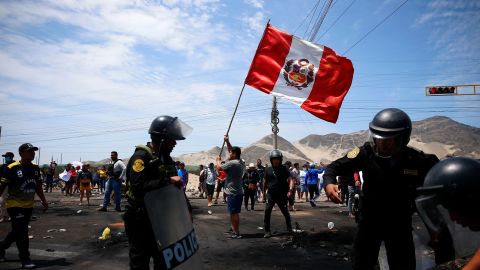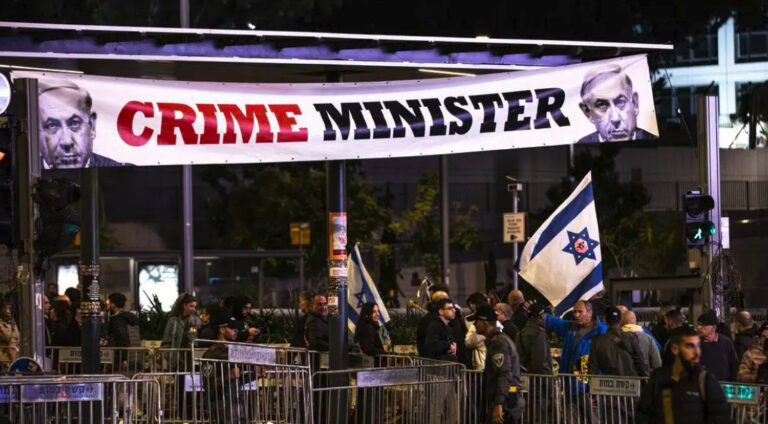
The foto has taken from CNN
STRATEGIC ASSESSMENT. With votes from Peru’s election on Sunday still being counted, there is widespread concern throughout the country that growing instability could lead to the resurgence of Sendero Luminoso (Shining Path), a Maoist insurgent group with a history of bloodshed and violence that terrorized Peru in the 1980s and 1990s. Overall, nearly 70,000 Peruvians, mostly unarmed civilians, were killed in fighting between the government and the insurgents. Following what has been labeled a “dirty war” for the savagery and indiscriminate brutality and human rights violations by all parties, Sendero Luminoso was crippled by the capture of its leader, Abimael Guzman in 1992. Following his capture and arrest, Sendero fractured into smaller splinter groups, and began focusing more on criminal activities than insurgency and terrorism, though there are still sporadic attacks against law enforcement and security forces. Reflecting this experience, during Peru’s term as Chair of the UN Security Council Counter-Terrorism Committee, they spearheaded negotiations and adoption of a resolution focused on the intersections of terrorism and organized crime – unanimously adopted as Resolution 2482 (2019).
But recent developments in Peru could suggest that a Sendero splinter group—the Militarized Communist Party of Peru—is making a comeback. Two weeks ago, sixteen people, including children, were massacred in the district of Vizcatan, located in Peru’s valley of the Apurimac, Ene and Mantaro rivers (often referred to as VRAEM), one of the leading coca-growing regions in the world and long a hotspot for terrorists, criminal organizations, and narco-traffickers. Attached to the dead bodies were pamphlets and propaganda attributed to a Sendero Luminoso splinter group. The VRAEM has been under a state of emergency since 2003 and is largely beyond the reach of the government. It is estimated that hundreds of thousands of peasant families in this region are employed by the illicit narcotics trade, as its value chain from farming to refinement to distribution has provided livelihoods to generations of Peruvians. This is especially the case in areas of the country where the government offers little to them. Because this is the case, the Peruvian police and military’s heavy-handed counternarcotics strategy and attempt to eradicate coca growing has often been counterproductive in “winning hearts and minds” of the population, one of the primary objectives of counterinsurgency.
During Sendero Luminoso’s apex in the 1980s, Peru was the world’s leading producer of coca leaf and coca paste. The COVID-19 pandemic has devastated Peru’s society and economy and if economic troubles persist, as many economists have forecasted, it will push more people below the poverty line. This could lead to more people searching for work in the informal economy, which includes the coca trade and illicit narcotics smuggling and trafficking. Last year, Peru’s gross domestic product (GDP) contracted by 11 percent. With 213 deaths per 100,000 people, Peru has the highest per capita COVID-19-related death rate in the world. Political volatility and widening socio-economic inequality have further attenuated Peru’s democratic institutions, and could benefit terrorist, insurgent, and criminal organizations looking to take advantage of mounting anger against the government to recruit new members and grow their organizations.
As occurred elsewhere throughout Latin America, including in Bolivia, Chile and Colombia, Peruvians took to the streets to participate in massive protests toward the end of 2020. Still, even a looming change in leadership will do little to assuage ordinary citizens—both current presidential candidates remain largely unpopular. First time candidate Pedro Castillo of the far-left Free-Peru Party is a rural schoolteacher who skyrocketed to prominence for his role in leading a teachers’ strike. Castillo has been slandered for his party’s Marxist-Leninist policies and accused of having sympathies for Sendero Luminoso front group The Movement for Amnesty and Fundamental Rights (MOVADEF) and its extreme far-left ideology, allegations Castillo forcefully denies. The other candidate for president is Keiko Fujimori, leader of the Popular Force party, who holds a slight lead following Sunday’s election as votes continue to be tallied. Keiko is the daughter of Peru’s former president Alberto Fujimori, whose claim to fame is the draconian war he waged on Sendero Luminoso in the 1990s. The former president is currently serving a 25-year prison sentence for corruption and other abuses. Upon taking office, the Biden administration had pledged to devote more attention and resources to Latin America than previous administrations had done. Peru’s election and the potential for a renewed insurgency in its rural hinterlands will be a test case to see if Washington will keep its promise, or continue to be consumed with ongoing crises in the Middle East and other traditional hotspots. Moreover, while many countries have focused counterterrorism concerns on the increased profile of violent far-right groups, the resurgence of groups like Sendero, and the possibility of similar iterations as the pandemic devastates economies and communities across the globe, will reiterate the need for international counterterrorism approaches that can be tailored to a wide range of threats (TSC).





